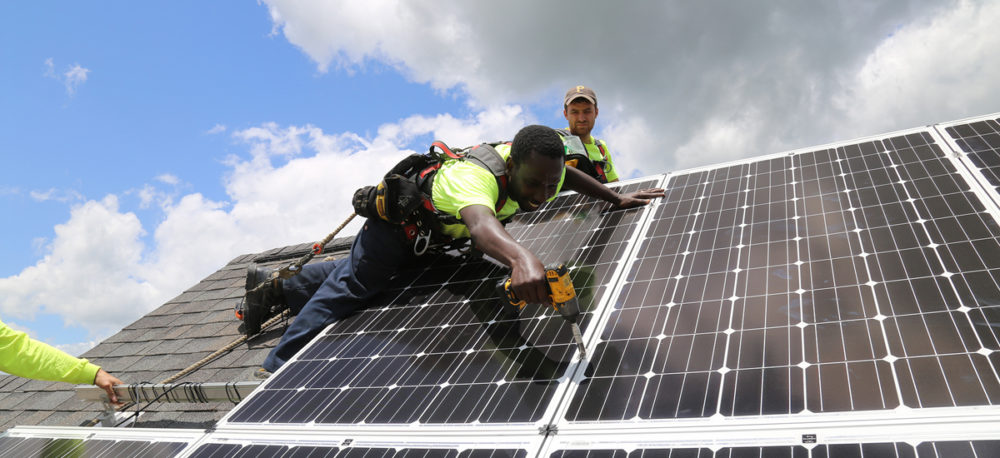When the Future Energy Jobs Bill (FEJA) passed the Illinois General Assembly and was later approved by Governor Rauner in early December last year, a key component of the legislation was to expand solar access for low-income communities. To get a feeling for how the legislation came about, I caught up with Naomi Davis, president and founder of the Chicago-based non-profit Blacks in Green (BIG). She has been on the front lines of developing this innovative program and is excited to finally see it coming together.
Illinois Solar for All
The Illinois Solar for All Program, a key piece of FEJA, provides funding to train and employ residents of low-income and economically disadvantaged communities, residents returning from the criminal justice system, and foster care graduates, in the solar installation industry. It’s a comprehensive solar deployment and job training program that will open access to the solar economy for thousands of Illinois residents.
For Naomi Davis, who has been advocating for renewable energy in a variety of platforms since BIG’s founding 10 years ago, Solar for All is a dream come true.
“[Solar For All] means the realization of a fundamental aim of BIG, which is to build an earned income business model for our non-profit,” Davis says. “We are launching BIG SOLAR in partnership with Millennium Solar and SunSwarm and creating a social enterprise for education and outreach, household subscriptions, workforce training and placement, design, installation, and maintenance of systems – residential, commercial, industrial, and are also exploring the development of a light solar pv assembly facility in West Woodlawn.”

The Solar for All program is a solar deployment and and job training initiative under FEJA.
The path to solar
The path to solar for all hasn’t been easy. “Not talked about is the sausage-making chaos of building a market almost from scratch, and the incredibly detailed and exhaustive examination of details and scenarios required,” admits Davis. She shares the camaraderie created when “folks who never talk to each other are huddled over time to understand the roles of the other and how to create economic harmony. That tiny organizations like BIG have to carry an incredible weight to stay at that table and ensure the interests of our constituents are represented.”
Although the legislation passed with many having a hand in its success, she highlights that communities of color are the unsung heroes of this legislation. Her organization’s affiliation and membership with the Chicago Environmental Justice Network was pivotal in having their needs considered. Among the organizations part of the network is the Little Village Environmental Justice Organization (LVEJO).
Juliana Pino, Policy Director for LVEJO, made sure the direction and content of the Future Energy Jobs Act took into consideration the needs of their community. It’s through their work, Davis says, that many of the benefits to communities of color now will be realized.
Solar growth benefits communities
According to the Low Income Solar Policy Guide, the growth of solar in the United States provides a significant opportunity to address some of the greatest challenges faced by lower-income communities: the high cost of housing, unemployment, and pollution. Solar can provide long-term financial relief to families struggling with high and unpredictable energy costs, living-wage employment opportunities in an industry adding jobs at a rate of 20 percent per year, and a source of clean, local energy sited in communities that have been disproportionately impacted by fossil fuel power generation.
According to Davis, Chris Williams, owner of Millennium Solar Electric, should be funded through this training. Davis says Williams is a third-generation African American IBEW electrician and founder of the now-reviving South Suburban Renewable Energy Association and go-to ComEd solar youth educator. Training and education are key.
Still, the work is hardly over. In fact, it’s just begun.
“As with any industry poised for enormous market share – in this case, energy – strategic tech training is essential,” says Davis. “Not just African Americans historically discriminated against, but also coal region towns desperately need the re-education this legislation can provide. Market forces are already finding cheaper sources than coal and without public dollars. Coal towns across Illinois and around the country all need what Solar for All provides – a better way forward.”
Community partnerships
Under the Illinois Solar for All Program, developers of community solar projects need to identify partnerships with community stakeholders to determine location, development, and participation in the projects. Communities will play a pivotal role in this program, and continuing to build partnerships is critical to its success.
Thanks to the Illinois Solar for All Program, Illinois is poised to bring more solar power to homes, communities, places of faith, and schools in every part of the state.

